The expansion of early learning and childcare: evaluation report 2017
A report exploring the impact of the expansion of government-funded early learning and childcare after 2014.
This document is part of a collection
2. Capacity
Key findings
- Comparing the delivery of funded ELC before and after the 2014 Act, it is estimated that between 2013 and 2016 the number of funded ELC hours delivered across Scotland increased by around 30%. This reflects both the expansion from 475 to 600 hours, and the extension of the funded entitlement to eligible two year olds.
- Over the same period the number of funded ELC capacity places for children increased by 4%, which was primarily created by an increase in capacity amongst local authority ELC providers and less so by increasing the number of funded places delivered through partner providers.
- There were differences between local authorities, with most showing an increase in capacity places and nine showing a decrease.
- Of the parents who do not use the entitlement for their eligible 2, 3 or 4 year old children, 17% gave as a reason that there are no available providers near them (0.3% of all eligible parents).
- The total workforce in settings delivering funded ELC in terms of full-time equivalents grew by around 6% between 2013 and 2016.
- The number of full time equivalent GTCS registered teachers in ELC settings providing the funded entitlement decreased from 1032 in 2015 to 915 in 2017. While teacher numbers decreased, teachers are not the only staff members working in the ELC sector with specialist qualifications. There were 2,316 FTE graduates with relevant degree level qualifications working in settings providing funded ELC in 2017, such as the BA in childhood practice introduced in 2009 (information collected for the first time in 2017).
An important condition for the success of the ELC expansion is that enough capacity is available to provide the hours of funded ELC across the country. This was true after the expansion in 2014 from 475 to 600 hours and to eligible two year olds, and even more so for the further expansion to 1140 hours by 2020.
To ensure that enough capacity is available by 2020, local authorities have to assess how many children will likely be eligible to the entitlement by 2020, and ensure sufficient ELC workforce and suitable infrastructure will be available by then, as well as other arrangements such as lunch provision if children stay longer hours.
This chapter gives an overview of evidence available on changes in the capacity for funded ELC. It will primarily focus on changes between 2013/14 and 2016/17, thereby providing both an indication of the change in capacity after the ELC expansion from 475 to 600 hours in 2014, and baseline measures for further monitoring change in capacity while the expansion to 1140 hours is being rolled out in the coming years.
Registered capacity places
Local authorities provide the funded ELC entitlement either directly in local authority settings or procured from partner providers in the private and voluntary sectors. Overall, local authority settings constitute the majority of funded ELC provision across Scotland
A key measure of the available supply of ELC places is 'registered capacity' which captures the maximum number of children that can receive ELC at any one point in time. Between 2013 (before the expansion of the ELC entitlement to 600 hours) and 2016 the registered capacity in Scotland increased by 4% from 107,725 to 111,884: [10]
Figure 2: Registered funded ELC capacity places in Scotland by provider category
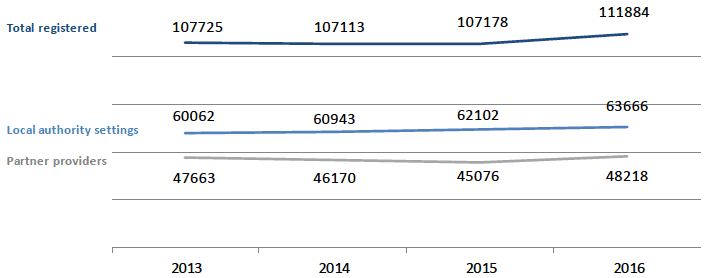
This growth of capacity has been predominately in the local authority settings; rising year on year between 2013 and 2016 from 60,062 to 63,666. Partner provider capacity declined between 2013 and 2015 from 47,663 to 45,076, and then increased substantially between 2015 and 2016 to 48,218. As registered capacity in partner providers also includes places receiving non-statutory unfunded ELC, drivers of demand and supply will be different from local authority settings. [11]
The 2017 ELC parent survey asked parents who don't take up their ELC entitlement for eligible 2, 3 and 4 year old children for their main reasons for this: 17% of them gave as a reason that there are no available providers near them. This means that 0.3% of all parents with eligible children say they are not using the funded entitlement because there are no available providers near them.
Registered capacity places across local authorities
Between 2013/14 and 2016/17 registered capacity places increased in most local authorities, with nine showing a decrease in capacity places:
Figure 3: Registered capacity places funded ELC provision (local authority and partner providers)
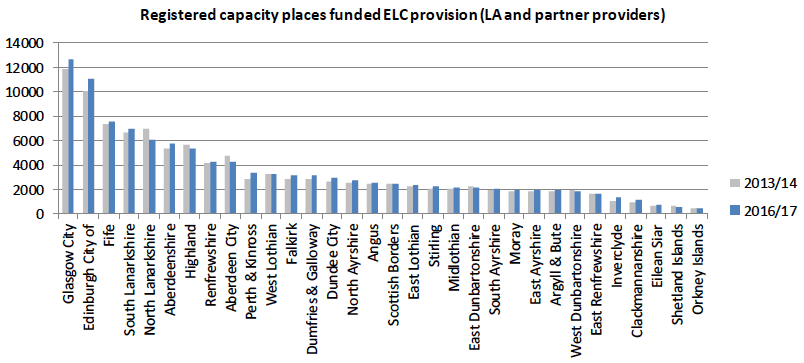
Figure 4 below shows that at a local authority level, the most substantial changes from 2013/14 to 2016/17 in registered capacity occurred in the partner provider sector. For example, in one local authority capacity in partner provider settings increased by 56% while in another it fell by 37%, due to changes in the number of partner settings providing the funded entitlement. In local authority settings the largest increase in registered capacity was 28%, and the largest decrease was 7%. Only five local authorities reported a decline in capacity in local authority settings, the majority reporting some level of growth between 2013/14 and 2016/17. More research would be needed to understand these differences; they might, for example, reflect differences in population trends across local authorities.
Figure 4: Change in registered capacity between 2013/14 and 2016/17 (%)
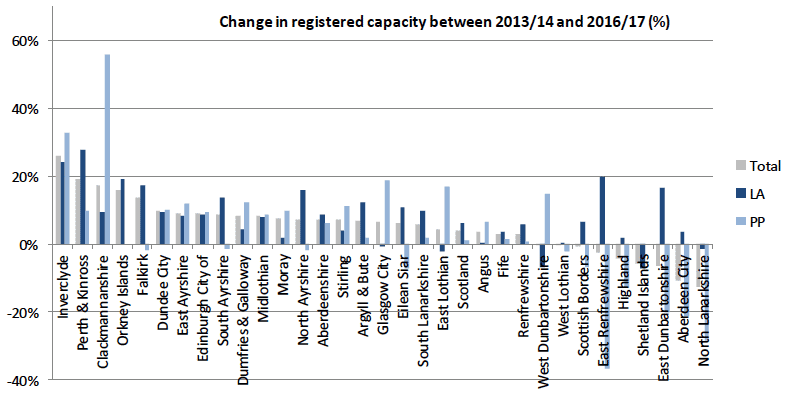
Registrations to capacity ratio
While each ELC provider has a number of capacity places that represent the maximum number of children permitted in a setting at any one point in time, different children can use a single capacity place over a period of time. For example, if a setting is open from 8am to 4pm, one child may use the capacity place from 8am to 12pm, and another child can use the place from 12pm to 4pm. In this example there is a 2:1 registrations to capacity ratio. Or in other words: two children registered per one capacity place.
The ratio of registrations to registered capacity can provide an insight into the utilisation of capacity of local authority settings and give an indication of how much unused space there is in the local authority ELC system. [12] The maximum possible number of registrations per capacity place depends on the average use of hours, operating times of ELC settings, and physical capacity places in the ELC system. Due to a lack of suitable information collected on the amount of hours used there is a limit to how much can be determined.
However, assuming children only receive their 600 hours entitlement, the maximum possible ratio will be around 2 registrations per capacity place in a setting that operates only during school term-time and school-hours, and up to 4 registrations per capacity place in a setting open all year and for extended hours. As will be further discussed in chapter 3, the majority of local authorities are increasing the provision of extended operating hours, which means that currently the theoretical maximum number of registrations per capacity place is between 2 and 4.
Between 2015/16 and 2016/17, an additional 1,564 capacity places were created in local authority ELC settings. This means that the ratio of registrations to capacity remained broadly stable at 1.48 children registered per capacity place.
Other things being equal, fewer registrations to capacity places suggest that ELC is being delivered less efficiently with more unused capacity in the system. However, if children are having longer hours of ELC, [13] a lower ratio may not mean that there is more unused capacity (because the registration figures do not take account of how long children spend in ELC). Chapter 7 will show evidence that immediately after the expansion to 600 hours in 2014 children indeed increased their average hours, but there is currently no robust evidence on whether an increase in the average hours children spent in ELC took place between 2015/16 and 2016/17.
At the national level the number of registrations to a capacity place is 1.48, but there is variation between local authorities. Island and large rural authorities showed the lowest number of registrations to capacity - close to a 1 to 1 basis. At the opposite end of the spectrum, the highest registrations per capacity ratio in a local authority is 1.79 children registered per one capacity place.
Workforce
A crucial aspect for building enough capacity to provide the 1140 hours is the availability of sufficient and suitably qualified ELC staff.
30% funded hours delivered
5% workforce headcount
Since the expansion of the funded entitlement from 475 hours to 600 hours, the size of the workforce headcount in settings delivering the funded entitlement has overall changed little: increasing by only around 5% between 2013 and 2016 while estimated hours of funded ELC delivered has increased by around 30% (including both the extra hours from the expansion from 475 to 600 hours and to additional eligible two year olds).
This finding might indicate an efficiency saving in the provision of ELC, but the figures should be interpreted with caution because the workforce figures for partner providers (and to a lesser extent in local authority providers) also include non-funded hours of ELC which may be provided in addition to the funded entitlement. If the increase in funded hours mostly replaced 'wrap around' self-funded hours, there would not have been a requirement for the workforce to increase as total hours (funded and non-funded) would have remained relatively stable. More analysis would be needed to better understand the difference between the increase in hours of ELC delivered and increase in workforce.
Figure 5 below gives a breakdown of the 5% increase in workforce headcount between 2013 and 2016. It shows that workforce growth in the local authority sector between 2013 and 2016 was 17%, but that this was offset by declines in the workforce in private (-2%) and voluntary (-13%) settings delivering the entitlement. [14] It should be noted that this might be due to local authority settings increasing their share of the funded provision and the share of partner provider settings reducing, rather than an actual reduction in the overall private and voluntary workforce (funded and non-funded settings).
Figure 5: Headcount ELC workforce in providers delivering the funded entitlement
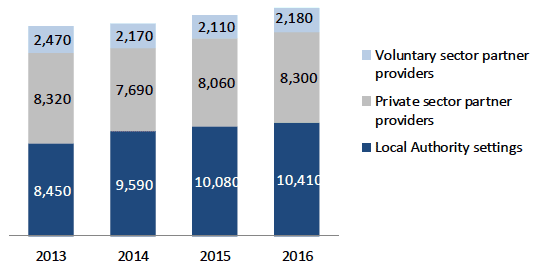
30% funded hours delivered
6% workforce FTE
When taking account of hours worked, and measuring workforce change on the basis of full-time equivalents, the growth between 2013 and 2016 has been slightly larger but still relatively small: a little more than 6% (19% in the local authority sector, 1% in the private sector and 6% in the voluntary sector) compared to an overall increase of funded ELC hours delivered of around 30%).
As above, this finding might indicate an efficiency saving in the provision of ELC, although the figures should be interpreted with some caution because the workforce figures also include non-funded hours of ELC that settings may provide in addition to the funded entitlement, and the difference might also reflect a replacement of privately-paid wrap around hours by funded hours after the expansion.
Qualifications of workforce and additional graduate commitment
To ensure that the quality of ELC does not suffer as the workforce grows, it is important that new and existing staff are sufficiently qualified. As part of this, the Scottish Government has made the commitment that by August 2018, nurseries in the most deprived areas will benefit from an additional graduate (435 additional graduates in total); either a graduate practitioner with a relevant degree or a teacher with Early Years expertise. [15] For this, the government is investing £1.5 million in 2017-18 to fund additional places for teacher training and the BA Childhood Practice award.
Teacher numbers and other degree-level qualified staff
Figure 6 below shows the number of full time equivalent ( FTE) GTCS registered teachers in local authority centres or local authority partners providing the ELC entitlement. It shows that this number decreased from 1,178 in 2014 to 915 in 2017. Since 2014, as part of on-going quality assurance measures, an additional check was put in place in the ELC census to eliminate double counting of teachers working in both ELC and schools. As a result, caution should be exercised when comparing the 2014 data with data after 2014.
Figure 6: Number of FTE GTCS registered teachers in local authority and partner provider ELC settings [16]
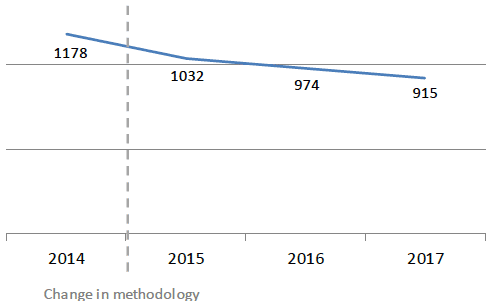
More information can be found in the Scottish Government's annual Early Learning and Childcare statistical publication and additional tables. [17]
While a decline can be seen in the number of FTE teachers in funded ELC providers, teachers are not the only staff members working in the ELC sector with specialist qualifications. There are also graduates with qualifications relevant to early years, such as the BA in Childhood Practice, which was introduced in 2009. The number of these graduates is higher than the number of teachers. In 2017 there were 2,316 FTE graduates with relevant degree level qualifications working in funded ELC providers. In 2017 there were also 994 FTE staff working towards the benchmark degree level qualifications required by the SSSC for registration as a manager / lead practitioner.
The table below shows the number of staff members in ELC settings [18] with or working towards relevant degree level [19] qualifications, other than teachers, in 2017 (in terms of headcount, not FTE):
| With a relevant degree level qualification | Working towards a relevant degree level qualification | |
|---|---|---|
| Manager/ Lead practitioner | 1,154 | 470 |
| Practitioner | 1,446 | 596 |
| Support Worker | 48 | 42 |
| Other | 23 | 11 |
This information was collected for the first time in the 2017 ELC census. [20] It will be collected annually from now on and used to monitor changes in the number of graduates in the coming years as the expansion to 1140 is rolled out.
To further monitor and evaluate the additional graduate commitment and other graduate-level ELC staff the Care Inspectorate has agreed with the Scottish Government to make additional graduates a specific focus area for the inspection year 2019-2020. This will assess amongst others to what extent graduate-level staff in ELC providers are employed in a way that promotes the delivery of high quality ELC and child development, as well as provide learning on good practice and barriers faced.
Parents' views on building capacity
The 2017 ELC parent survey provided parents with an opportunity to provide any other comments in relation to the planned expansion of funded ELC entitlement. 29% (over 3000) of survey participants provided comments here. A large majority of these (around 3 in 4) were positive comments in support of the planned expansion.
This included a large number of parents providing short statements expressing general support for the expansion, including some who wished to see the expanded entitlement introduced earlier. One parent said, for example:
"The cost of childcare made it difficult for me to justify going back to work. I went back part time but barely covered the costs and I now work full time. My husband…works shifts and this is the only way we manage to juggle childcare versus cost. I wish this funding had been available to us but I really welcome it being made available for others in the future. I really believe mothers should have the option to work if they wish and currently with two children or more this option is taken from many on lower salaries!"
Other, less positive comments included some parents (around 1 in 7 of those making comments) who seemed broadly supportive of the planned expansion but who also raised concerns about how the expansion will be delivered. For example, one parent said
"Extension of hours will not necessarily help all working parents, or encourage them to choose other service provision away from private providers because wrap around care will still not be provided by some nurseries; therefore the extension of hours will not necessarily increase choice to parents."
Parents also raised some concerns about whether sufficient capacity and resources will be available to deliver the additional hours. This included references to difficulties encountered in securing suitable provision in some areas. Some specifically questioned the extent to which local authority nurseries would have sufficient capacity to deliver the expanded entitlement and asked if and how other providers would have a role here.
"A lot of consideration needs to come in on how nurseries will cope with this change. Numbers and places are already stretched in many places. Partner providers could seriously struggle to accommodate this."
"The traditional nursery or school day does not work or fit around parents' working hours - will Childminders and 'wrap around' care facilities be able to provide this?"
Contact
There is a problem
Thanks for your feedback